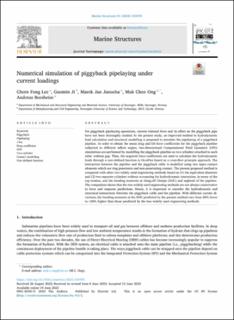| dc.contributor.author | Lee, Chern Fong | |
| dc.contributor.author | Ji, Guomin | |
| dc.contributor.author | Janocha, Marek Jan | |
| dc.contributor.author | Ong, Muk Chen | |
| dc.contributor.author | Borsheim, Andreas | |
| dc.date.accessioned | 2023-09-14T12:59:07Z | |
| dc.date.available | 2023-09-14T12:59:07Z | |
| dc.date.created | 2023-06-30T11:27:47Z | |
| dc.date.issued | 2023 | |
| dc.identifier.citation | Lee, C.F., Ji, G., Janocha, M.J., Ong, M.C., Borsheim, A. (2023) Numerical simulation of piggyback pipelaying under current loadings. Marine Structures, 91, 103478. | en_US |
| dc.identifier.issn | 0951-8339 | |
| dc.identifier.uri | https://hdl.handle.net/11250/3089518 | |
| dc.description.abstract | For piggyback pipelaying operations, current-induced force and its effect on the piggyback pipe have not been thoroughly studied. In the present study, an improved method in hydrodynamic load calculation and structural modelling is proposed to simulate the pipelaying of a piggyback pipeline. In order to obtain the mean drag and lift force coefficients for the piggyback pipeline subjected to different inflow angles, two-dimensional Computational Fluid Dynamics (CFD) simulations are performed by modelling the piggyback pipeline as two cylinders attached to each other without gap. Then, the acquired force coefficients are used to calculate the hydrodynamic loads through a user-defined function in OrcaFlex based on a cross-flow principle approach. The interaction between the pipeline and the piggyback cable is modelled using two types contact elements which are ring penetrator and non-penetrating contact. The present proposed method is compared with other two widely used engineering methods based on (1) the equivalent diameter and (2) two separate cylinders without accounting for hydrodynamic interaction, in terms of the top tension, and the bending moments at Hang-off Clamps (HOC) and sagbend of the pipeline. The comparison shows that the two widely used engineering methods are not always conservative in force and response predictions. Hence, it is important to consider the hydrodynamic and structural interactions between the piggyback cable and the pipeline. With different current directions, the bending moments at the HOC predicted by the present method vary from 40% lower to 100% higher than those predicted by the two widely used engineering methods. | en_US |
| dc.language.iso | eng | en_US |
| dc.rights | Navngivelse 4.0 Internasjonal | * |
| dc.rights.uri | http://creativecommons.org/licenses/by/4.0/deed.no | * |
| dc.subject | undervannsteknologi | en_US |
| dc.subject | pipelines | en_US |
| dc.subject | konstruksjoner og materialer | en_US |
| dc.title | Numerical simulation of piggyback pipelaying under current loadings | en_US |
| dc.type | Peer reviewed | en_US |
| dc.type | Journal article | en_US |
| dc.description.version | publishedVersion | en_US |
| dc.rights.holder | © 2023 The Author(s). | en_US |
| dc.subject.nsi | VDP::Teknologi: 500::Marin teknologi: 580 | en_US |
| dc.source.volume | 91 | en_US |
| dc.source.journal | Marine Structures | en_US |
| dc.identifier.doi | 10.1016/j.marstruc.2023.103478 | |
| dc.identifier.cristin | 2159796 | |
| dc.source.articlenumber | 103478 | en_US |
| cristin.ispublished | true | |
| cristin.fulltext | original | |
| cristin.qualitycode | 2 | |

